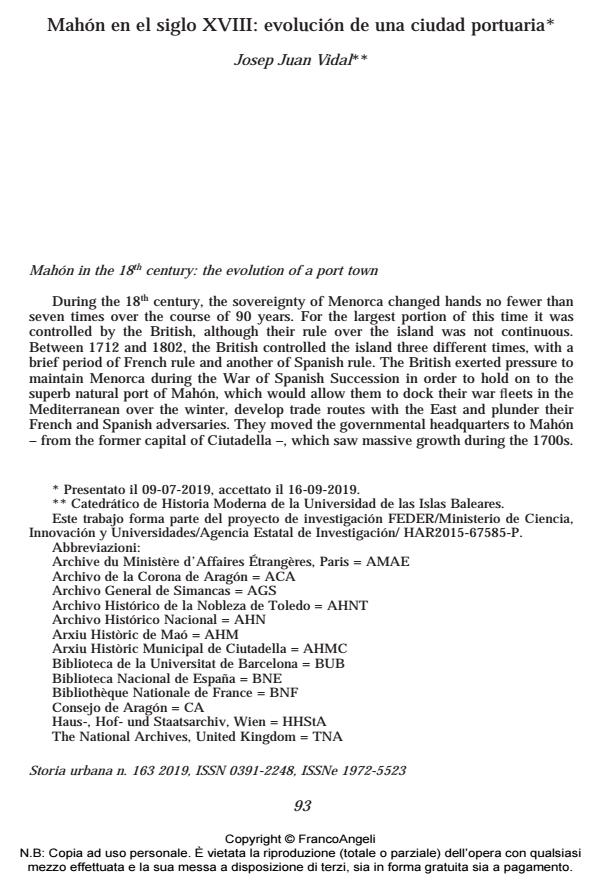Mahón in the 18th century: the evolution of a port town
Journal title STORIA URBANA
Author/s Josep Juan Vidal
Publishing Year 2020 Issue 2019/163
Language Italian Pages 23 P. 93-115 File size 82 KB
DOI 10.3280/SU2019-163006
DOI is like a bar code for intellectual property: to have more infomation
click here
Below, you can see the article first page
If you want to buy this article in PDF format, you can do it, following the instructions to buy download credits

FrancoAngeli is member of Publishers International Linking Association, Inc (PILA), a not-for-profit association which run the CrossRef service enabling links to and from online scholarly content.
During the 18th century, the sovereignty of Menorca changed hands no fewer than seven times over the course of 90 years. For the largest portion of this time it was controlled by the British, although their rule over the island was not continuous. Between 1712 and 1802, the British controlled the island three different times, with a brief period of French rule and another of Spanish rule. The British exerted pressure to maintain Menorca during the War of Spanish Succession in order to hold on to the superb natural port of Mahón, which would allow them to dock their war fleets in the Mediterranean over the winter, develop trade routes with the East and plunder their French and Spanish adversaries. They moved the governmental headquarters to Mahón - from the former capital of Ciutadella , which saw massive growth during the 1700s. Various population surveys from the British, French and Spanish eras attest to this growth. The population tripled over a span of 80 years, and by the end of the century, it had reached 16,000 inhabitants. The city of Mahón became a center for trade between the eastern and western Mediterranean. Additionally, a shipyard was created where ships could be built and repaired. The city also served as an important base for privateers. The significant trading activity that took place there and its maritime importance even attracted colonies of foreigners, Greeks, Jews, and Italians.
Nel XVIII secolo l’isola di Minorca cambiò di sovrano ben sette volte nel giro di novant’anni. Durante la maggior parte del secolo rimase sotto il dominio britannico, seppur attraversando varie fasi. Tra il 1712 e il 1802 conobbe ben tre domini britannici alternati a due brevi periodi di dominio, rispettivamente, francese e spagnolo. Durante la guerra di successione i britannici fecero pressione sulla Corona di Spagna per tenersi Minorca. Il loro scopo era quello di possedere il magnifico porto naturale di Mahón, che avrebbe permesso loro di far trascorrere l’inverno alle rispettive flotte da guerra nel Mediterraneo, svolgere attività commerciali con l’Oriente e praticare la guerra di corsa contro i rispettivi avversari, ovvero francesi e spagnoli. Trasferirono le istituzioni governative da Ciutadella, allora capitale dell’isola, a Mahón, località che conobbe un’incredibile crescita nel Settecento, incremento tra l’altro confermato anche da diversi studi demografici custoditi in vari archivi e svolti durante i domini britannico, francese e spagnolo. In ottant’anni, la popolazione del nuovo capoluogo triplicò, superando i 16.000 abitanti a fine secolo. Mahón si specializzò nel commercio di ridistribuzione tra Oriente e Occidente mediterraneo e, oltre a ospitare un arsenale per la costruzione e riparazione di imbarcazioni, divenne un’importante base corsara. Infine, grazie alla sua potente attività commerciale e nautica attirò colonie straniere (greche, ebree e italiane).
Keywords: Menorca, commerce, arsenal, population growth, English navy.
Josep Juan Vidal, Mahón en el siglo XVIII: evolución de una ciudad portuaria in "STORIA URBANA " 163/2019, pp 93-115, DOI: 10.3280/SU2019-163006